Xun Lin
SVC 2025: the First Multimodal Deception Detection Challenge
Aug 06, 2025Abstract:Deception detection is a critical task in real-world applications such as security screening, fraud prevention, and credibility assessment. While deep learning methods have shown promise in surpassing human-level performance, their effectiveness often depends on the availability of high-quality and diverse deception samples. Existing research predominantly focuses on single-domain scenarios, overlooking the significant performance degradation caused by domain shifts. To address this gap, we present the SVC 2025 Multimodal Deception Detection Challenge, a new benchmark designed to evaluate cross-domain generalization in audio-visual deception detection. Participants are required to develop models that not only perform well within individual domains but also generalize across multiple heterogeneous datasets. By leveraging multimodal data, including audio, video, and text, this challenge encourages the design of models capable of capturing subtle and implicit deceptive cues. Through this benchmark, we aim to foster the development of more adaptable, explainable, and practically deployable deception detection systems, advancing the broader field of multimodal learning. By the conclusion of the workshop competition, a total of 21 teams had submitted their final results. https://sites.google.com/view/svc-mm25 for more information.
FaceShield: Explainable Face Anti-Spoofing with Multimodal Large Language Models
May 14, 2025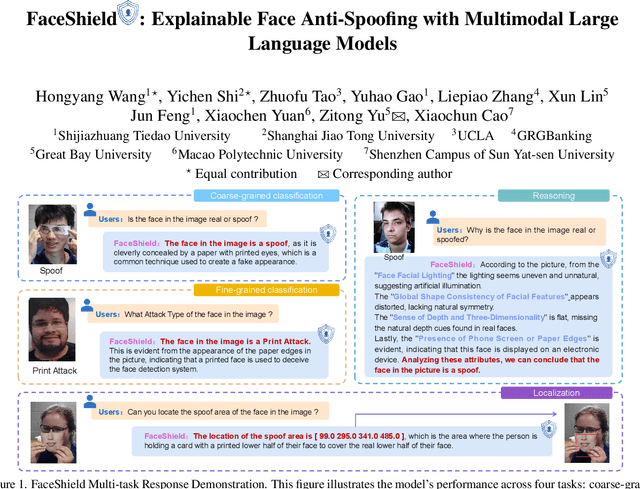
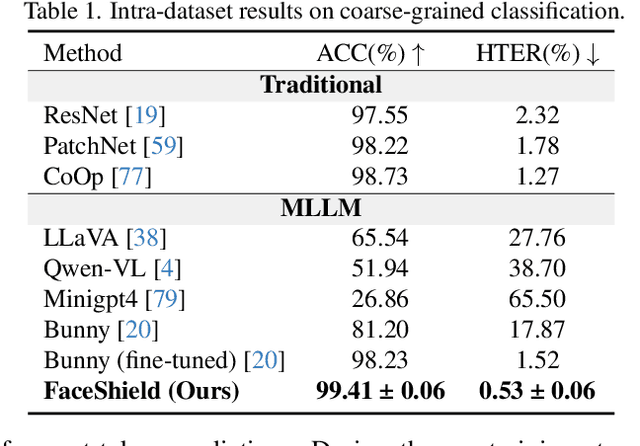
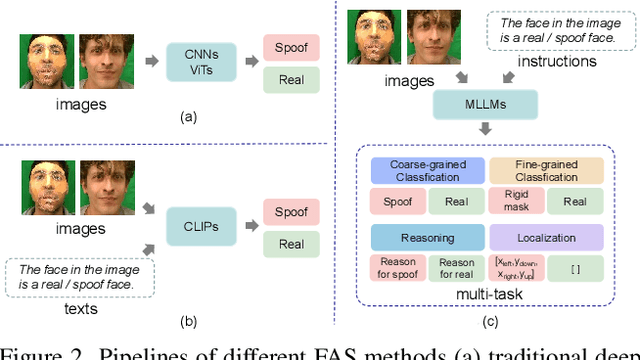
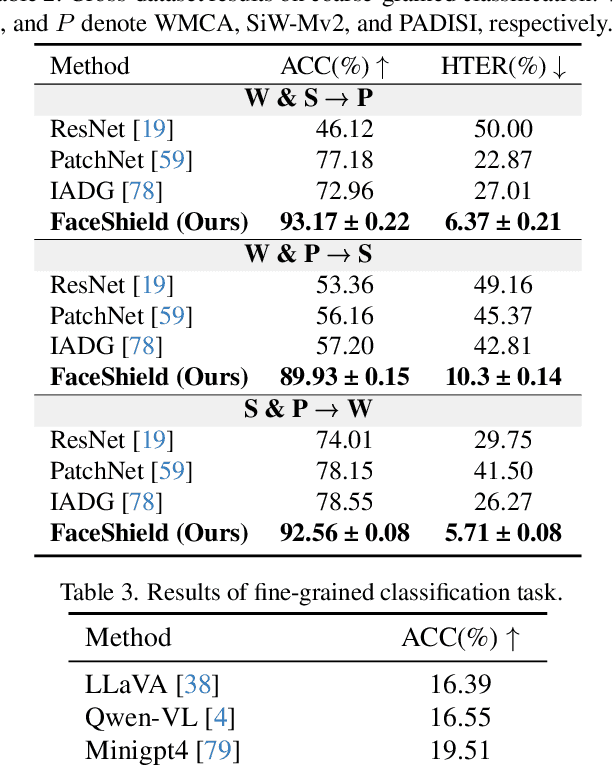
Abstract:Face anti-spoofing (FAS) is crucial for protecting facial recognition systems from presentation attacks. Previous methods approached this task as a classification problem, lacking interpretability and reasoning behind the predicted results. Recently, multimodal large language models (MLLMs) have shown strong capabilities in perception, reasoning, and decision-making in visual tasks. However, there is currently no universal and comprehensive MLLM and dataset specifically designed for FAS task. To address this gap, we propose FaceShield, a MLLM for FAS, along with the corresponding pre-training and supervised fine-tuning (SFT) datasets, FaceShield-pre10K and FaceShield-sft45K. FaceShield is capable of determining the authenticity of faces, identifying types of spoofing attacks, providing reasoning for its judgments, and detecting attack areas. Specifically, we employ spoof-aware vision perception (SAVP) that incorporates both the original image and auxiliary information based on prior knowledge. We then use an prompt-guided vision token masking (PVTM) strategy to random mask vision tokens, thereby improving the model's generalization ability. We conducted extensive experiments on three benchmark datasets, demonstrating that FaceShield significantly outperforms previous deep learning models and general MLLMs on four FAS tasks, i.e., coarse-grained classification, fine-grained classification, reasoning, and attack localization. Our instruction datasets, protocols, and codes will be released soon.
Denoising and Alignment: Rethinking Domain Generalization for Multimodal Face Anti-Spoofing
May 14, 2025Abstract:Face Anti-Spoofing (FAS) is essential for the security of facial recognition systems in diverse scenarios such as payment processing and surveillance. Current multimodal FAS methods often struggle with effective generalization, mainly due to modality-specific biases and domain shifts. To address these challenges, we introduce the \textbf{M}ulti\textbf{m}odal \textbf{D}enoising and \textbf{A}lignment (\textbf{MMDA}) framework. By leveraging the zero-shot generalization capability of CLIP, the MMDA framework effectively suppresses noise in multimodal data through denoising and alignment mechanisms, thereby significantly enhancing the generalization performance of cross-modal alignment. The \textbf{M}odality-\textbf{D}omain Joint \textbf{D}ifferential \textbf{A}ttention (\textbf{MD2A}) module in MMDA concurrently mitigates the impacts of domain and modality noise by refining the attention mechanism based on extracted common noise features. Furthermore, the \textbf{R}epresentation \textbf{S}pace \textbf{S}oft (\textbf{RS2}) Alignment strategy utilizes the pre-trained CLIP model to align multi-domain multimodal data into a generalized representation space in a flexible manner, preserving intricate representations and enhancing the model's adaptability to various unseen conditions. We also design a \textbf{U}-shaped \textbf{D}ual \textbf{S}pace \textbf{A}daptation (\textbf{U-DSA}) module to enhance the adaptability of representations while maintaining generalization performance. These improvements not only enhance the framework's generalization capabilities but also boost its ability to represent complex representations. Our experimental results on four benchmark datasets under different evaluation protocols demonstrate that the MMDA framework outperforms existing state-of-the-art methods in terms of cross-domain generalization and multimodal detection accuracy. The code will be released soon.
Towards Model Resistant to Transferable Adversarial Examples via Trigger Activation
Apr 20, 2025Abstract:Adversarial examples, characterized by imperceptible perturbations, pose significant threats to deep neural networks by misleading their predictions. A critical aspect of these examples is their transferability, allowing them to deceive {unseen} models in black-box scenarios. Despite the widespread exploration of defense methods, including those on transferability, they show limitations: inefficient deployment, ineffective defense, and degraded performance on clean images. In this work, we introduce a novel training paradigm aimed at enhancing robustness against transferable adversarial examples (TAEs) in a more efficient and effective way. We propose a model that exhibits random guessing behavior when presented with clean data $\boldsymbol{x}$ as input, and generates accurate predictions when with triggered data $\boldsymbol{x}+\boldsymbol{\tau}$. Importantly, the trigger $\boldsymbol{\tau}$ remains constant for all data instances. We refer to these models as \textbf{models with trigger activation}. We are surprised to find that these models exhibit certain robustness against TAEs. Through the consideration of first-order gradients, we provide a theoretical analysis of this robustness. Moreover, through the joint optimization of the learnable trigger and the model, we achieve improved robustness to transferable attacks. Extensive experiments conducted across diverse datasets, evaluating a variety of attacking methods, underscore the effectiveness and superiority of our approach.
AdaMHF: Adaptive Multimodal Hierarchical Fusion for Survival Prediction
Mar 27, 2025Abstract:The integration of pathologic images and genomic data for survival analysis has gained increasing attention with advances in multimodal learning. However, current methods often ignore biological characteristics, such as heterogeneity and sparsity, both within and across modalities, ultimately limiting their adaptability to clinical practice. To address these challenges, we propose AdaMHF: Adaptive Multimodal Hierarchical Fusion, a framework designed for efficient, comprehensive, and tailored feature extraction and fusion. AdaMHF is specifically adapted to the uniqueness of medical data, enabling accurate predictions with minimal resource consumption, even under challenging scenarios with missing modalities. Initially, AdaMHF employs an experts expansion and residual structure to activate specialized experts for extracting heterogeneous and sparse features. Extracted tokens undergo refinement via selection and aggregation, reducing the weight of non-dominant features while preserving comprehensive information. Subsequently, the encoded features are hierarchically fused, allowing multi-grained interactions across modalities to be captured. Furthermore, we introduce a survival prediction benchmark designed to resolve scenarios with missing modalities, mirroring real-world clinical conditions. Extensive experiments on TCGA datasets demonstrate that AdaMHF surpasses current state-of-the-art (SOTA) methods, showcasing exceptional performance in both complete and incomplete modality settings.
BIG-MoE: Bypass Isolated Gating MoE for Generalized Multimodal Face Anti-Spoofing
Dec 24, 2024Abstract:In the domain of facial recognition security, multimodal Face Anti-Spoofing (FAS) is essential for countering presentation attacks. However, existing technologies encounter challenges due to modality biases and imbalances, as well as domain shifts. Our research introduces a Mixture of Experts (MoE) model to address these issues effectively. We identified three limitations in traditional MoE approaches to multimodal FAS: (1) Coarse-grained experts' inability to capture nuanced spoofing indicators; (2) Gated networks' susceptibility to input noise affecting decision-making; (3) MoE's sensitivity to prompt tokens leading to overfitting with conventional learning methods. To mitigate these, we propose the Bypass Isolated Gating MoE (BIG-MoE) framework, featuring: (1) Fine-grained experts for enhanced detection of subtle spoofing cues; (2) An isolation gating mechanism to counteract input noise; (3) A novel differential convolutional prompt bypass enriching the gating network with critical local features, thereby improving perceptual capabilities. Extensive experiments on four benchmark datasets demonstrate significant generalization performance improvement in multimodal FAS task. The code is released at https://github.com/murInJ/BIG-MoE.
EPE-P: Evidence-based Parameter-efficient Prompting for Multimodal Learning with Missing Modalities
Dec 23, 2024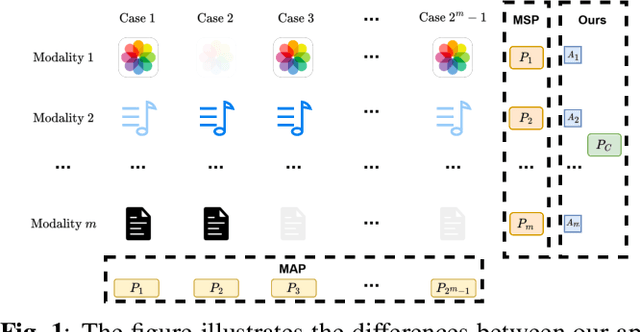
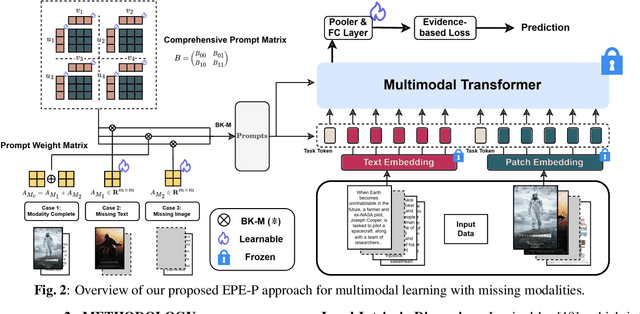
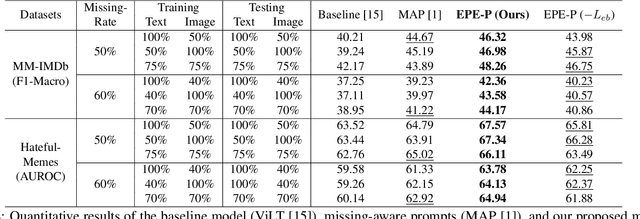
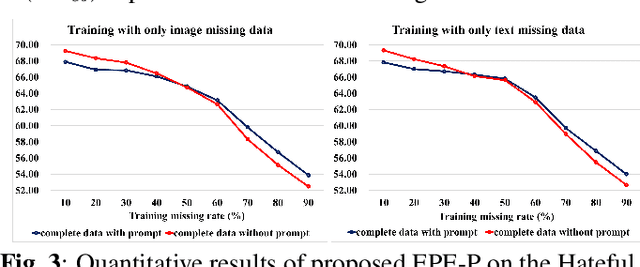
Abstract:Missing modalities are a common challenge in real-world multimodal learning scenarios, occurring during both training and testing. Existing methods for managing missing modalities often require the design of separate prompts for each modality or missing case, leading to complex designs and a substantial increase in the number of parameters to be learned. As the number of modalities grows, these methods become increasingly inefficient due to parameter redundancy. To address these issues, we propose Evidence-based Parameter-Efficient Prompting (EPE-P), a novel and parameter-efficient method for pretrained multimodal networks. Our approach introduces a streamlined design that integrates prompting information across different modalities, reducing complexity and mitigating redundant parameters. Furthermore, we propose an Evidence-based Loss function to better handle the uncertainty associated with missing modalities, improving the model's decision-making. Our experiments demonstrate that EPE-P outperforms existing prompting-based methods in terms of both effectiveness and efficiency. The code is released at https://github.com/Boris-Jobs/EPE-P_MLLMs-Robustness.
Backdoor Attacks against No-Reference Image Quality Assessment Models via A Scalable Trigger
Dec 10, 2024



Abstract:No-Reference Image Quality Assessment (NR-IQA), responsible for assessing the quality of a single input image without using any reference, plays a critical role in evaluating and optimizing computer vision systems, e.g., low-light enhancement. Recent research indicates that NR-IQA models are susceptible to adversarial attacks, which can significantly alter predicted scores with visually imperceptible perturbations. Despite revealing vulnerabilities, these attack methods have limitations, including high computational demands, untargeted manipulation, limited practical utility in white-box scenarios, and reduced effectiveness in black-box scenarios. To address these challenges, we shift our focus to another significant threat and present a novel poisoning-based backdoor attack against NR-IQA (BAIQA), allowing the attacker to manipulate the IQA model's output to any desired target value by simply adjusting a scaling coefficient $\alpha$ for the trigger. We propose to inject the trigger in the discrete cosine transform (DCT) domain to improve the local invariance of the trigger for countering trigger diminishment in NR-IQA models due to widely adopted data augmentations. Furthermore, the universal adversarial perturbations (UAP) in the DCT space are designed as the trigger, to increase IQA model susceptibility to manipulation and improve attack effectiveness. In addition to the heuristic method for poison-label BAIQA (P-BAIQA), we explore the design of clean-label BAIQA (C-BAIQA), focusing on $\alpha$ sampling and image data refinement, driven by theoretical insights we reveal. Extensive experiments on diverse datasets and various NR-IQA models demonstrate the effectiveness of our attacks. Code will be released at https://github.com/yuyi-sd/BAIQA.
Transferable Adversarial Attacks on SAM and Its Downstream Models
Oct 29, 2024Abstract:The utilization of large foundational models has a dilemma: while fine-tuning downstream tasks from them holds promise for making use of the well-generalized knowledge in practical applications, their open accessibility also poses threats of adverse usage. This paper, for the first time, explores the feasibility of adversarial attacking various downstream models fine-tuned from the segment anything model (SAM), by solely utilizing the information from the open-sourced SAM. In contrast to prevailing transfer-based adversarial attacks, we demonstrate the existence of adversarial dangers even without accessing the downstream task and dataset to train a similar surrogate model. To enhance the effectiveness of the adversarial attack towards models fine-tuned on unknown datasets, we propose a universal meta-initialization (UMI) algorithm to extract the intrinsic vulnerability inherent in the foundation model, which is then utilized as the prior knowledge to guide the generation of adversarial perturbations. Moreover, by formulating the gradient difference in the attacking process between the open-sourced SAM and its fine-tuned downstream models, we theoretically demonstrate that a deviation occurs in the adversarial update direction by directly maximizing the distance of encoded feature embeddings in the open-sourced SAM. Consequently, we propose a gradient robust loss that simulates the associated uncertainty with gradient-based noise augmentation to enhance the robustness of generated adversarial examples (AEs) towards this deviation, thus improving the transferability. Extensive experiments demonstrate the effectiveness of the proposed universal meta-initialized and gradient robust adversarial attack (UMI-GRAT) toward SAMs and their downstream models. Code is available at https://github.com/xiasong0501/GRAT.
DAAD: Dynamic Analysis and Adaptive Discriminator for Fake News Detection
Aug 20, 2024Abstract:In current web environment, fake news spreads rapidly across online social networks, posing serious threats to society. Existing multimodal fake news detection (MFND) methods can be classified into knowledge-based and semantic-based approaches. However, these methods are overly dependent on human expertise and feedback, lacking flexibility. To address this challenge, we propose a Dynamic Analysis and Adaptive Discriminator (DAAD) approach for fake news detection. For knowledge-based methods, we introduce the Monte Carlo Tree Search (MCTS) algorithm to leverage the self-reflective capabilities of large language models (LLMs) for prompt optimization, providing richer, domain-specific details and guidance to the LLMs, while enabling more flexible integration of LLM comment on news content. For semantic-based methods, we define four typical deceit patterns: emotional exaggeration, logical inconsistency, image manipulation, and semantic inconsistency, to reveal the mechanisms behind fake news creation. To detect these patterns, we carefully design four discriminators and expand them in depth and breadth, using the soft-routing mechanism to explore optimal detection models. Experimental results on three real-world datasets demonstrate the superiority of our approach. The code will be available at: https://github.com/SuXinqi/DAAD.
 Add to Chrome
Add to Chrome Add to Firefox
Add to Firefox Add to Edge
Add to Edge